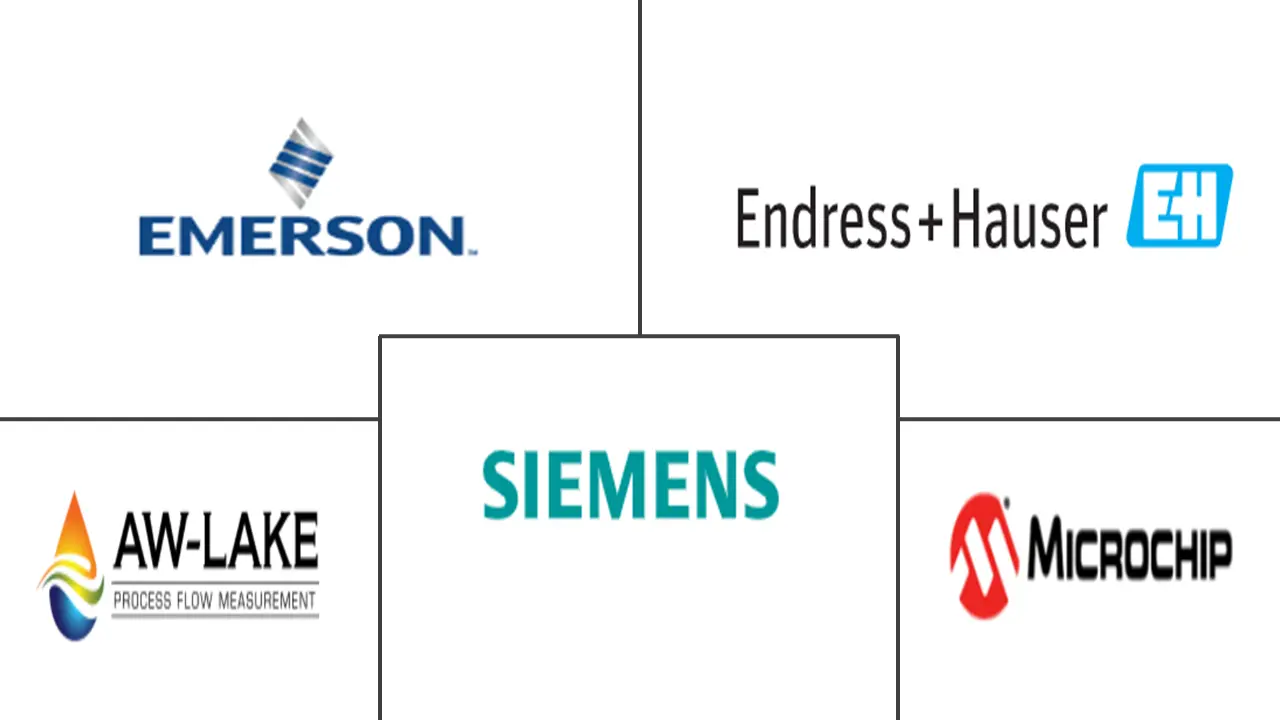Wireless Flow Sensors Market Size and Share
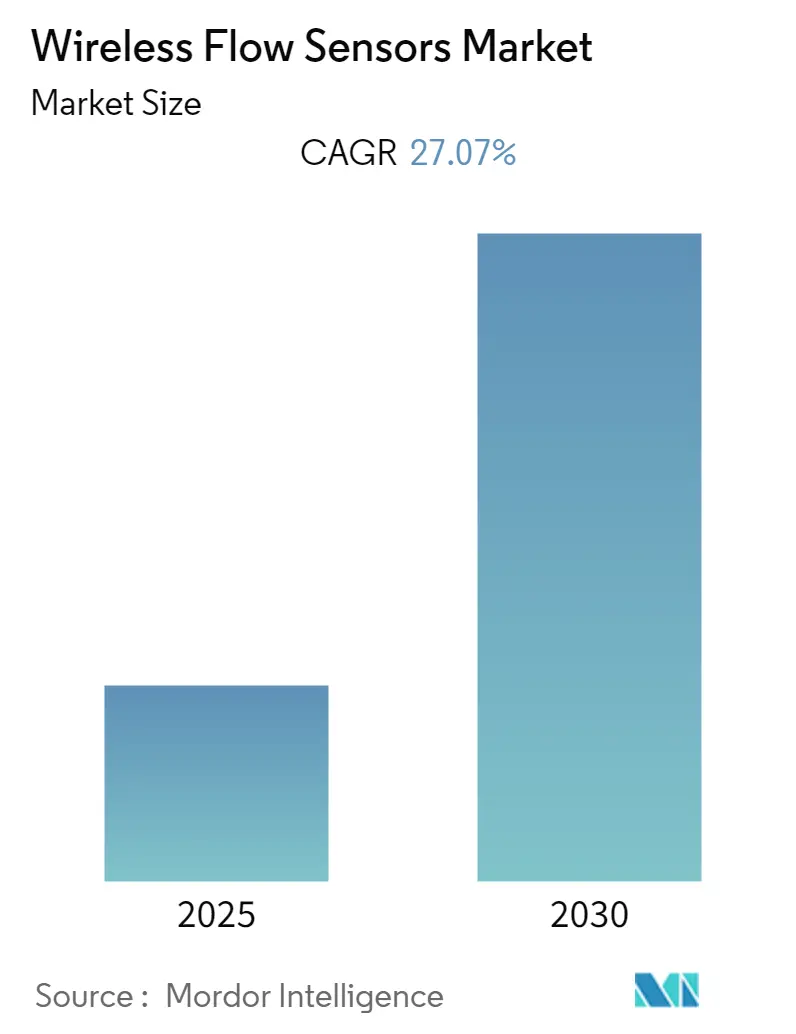
Wireless Flow Sensors Market Analysis by Mordor Intelligence
The Wireless Flow Sensors Market is expected to register a CAGR of 27.07% during the forecast period.
- The revival of the oil and gas industry and the expanding infrastructure in the water and wastewater industry are likely to drive growth in the medium to long term. Growth opportunities are opening in developing economies, such as China and India, that have developed their oil, gas, and chemical industries.
- The increasing quest for new energy sources, renewable energy development, government regulations, and rapid technological advancements are the key drivers making the wireless flow sensors market grow with a boom. The demand for wireless flow sensors is increasing significantly as it saves time, materials, and labor. With modern microelectronics, flowmeters offer many communication options.
- Flow sensors can detect leaks, blockages, pipe bursts, and changes in liquid concentration due to contamination or pollution. Ultrasonic flow sensors are the most popular type of non-contact flow sensor. Ultrasonic flow sensors send high-frequency sound pulses across the flowing liquid or gas medium. These sensors measure the time between the emission of the sound and its contact with the sensor's receiver to determine the flow rate of the gas or liquid.
- Increasing advancements, such as incorporating new protocols to ease the connection to enterprise networks, are further boosting market growth. For instance, a flow sensor can have an Open Platform Communication - Unified Architecture (OPC-UA) server application package built into the flowmeter, allowing the device to communicate with an OPC-UA client and be integrated into Industrial Internet of Things (IIoT) applications. This is accomplished through networking the flowmeter via either LAN or WLAN, which allows the DCS or PLC to be dedicated to the control function. In contrast, this additional communication path can be devoted to diagnostic, monitoring, and reporting purposes.
- The COVID-19 pandemic positively impacted the wireless flow sensors market. According to the World Health Organization (WHO), the water supply had to be kept safe, owing to the chances of virus transmission that could quickly grow through sewage. This factor drove the adoption of biological wastewater treatment systems and propelled the growth of the wireless flow sensors market during the pandemic. Government bodies and non-profit organizations created awareness about water safety and security during the pandemic.
Global Wireless Flow Sensors Market Trends and Insights
Increasing Adoption of Wireless Technologies to Drive the Market Growth
- Wireless sensors are advantageous over wireline, with a broader range of features and compatibility, faster response, and lower power consumption. Growing investments by leading players and the demand for wireless technologies from end-user industries support the market.
- With many companies moving toward wireless, production costs are declining, enabling broader market consumption. However, a lack of awareness and capital in developing markets and a strong foothold of wireline sensors in traditional markets are restraining the growth of wireless sensors, with many consumers being skeptical about adopting new technologies. Moreover, the increasing adoption of Wi-Fi and WLAN across the globe is driving the wireless sensor market.
- Flow sensors can now shortcut the once-complex procedure of getting flow and status information to SCADA (Supervisory Control and Data Acquisition), CMMS (Computerized Maintenance Management System), ERP (Enterprise Resource Planning), and other enterprise-level networks. With these communication capabilities, the software can easily access the data it needs directly from the device.
- Mobile technology is also working its way into flow sensors. Flowmeters already have wireless, Bluetooth, and web server capabilities, which means flowmeters can be accessed, probed, configured, and diagnosed over smartphones, tablets, and handheld devices. Such benefits of wireless flow sensors are mainly fueling the market demand.
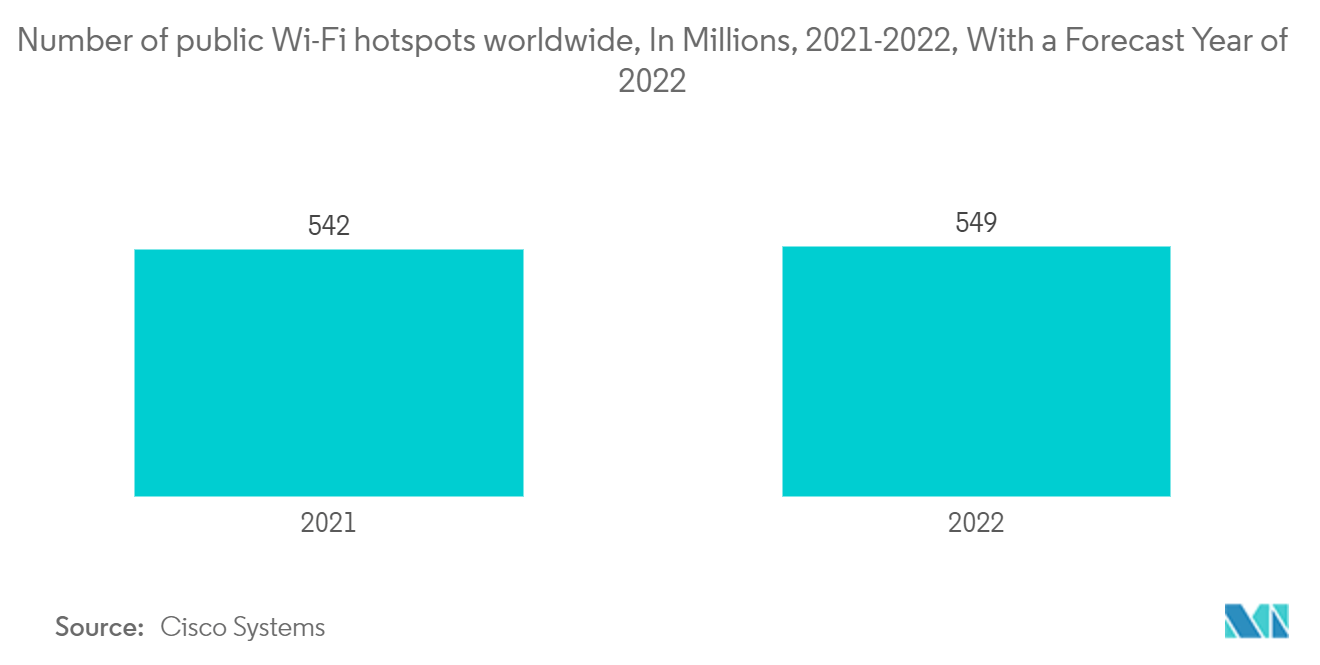
North America to Witness Significant Growth
- The United States is North America's largest consumer of wireless flow sensors. Wireless flow sensors occupy a major share in the United States, with significant demand from the water and wastewater industry.
- The market in the United States is driven by technology, with consumers preferring products offering the latest technology with reliable performance. Thus, wireless flow meters are becoming extremely popular among the end-users in this country.
- Huge investments and legislative initiatives on wireless technology in countries such as the United States and Canada have fuelled market growth in the North American region. Moreover, the region's augmentation of WSN (wireless sensor network) is expected to bolster the market demand for these sensors.
- With many large companies being established players in the market, the US remains one of the prominent countries globally. Growing applications of plastic in industrial and consumer markets result in industrial waste. Approximately 80% of the hundreds of millions of tons of plastics used in the US annually end up in landfills. Another 15% was incinerated, and 5% was recycled, according to pumps and systems, in September 2022.
- As industrial waste increases worldwide, it also increases global pollution that endangers drinking water and air. Understanding the importance of reducing industrial waste, some manufacturers are turning waste into clean fuels. More specifically, they are turning plastic waste materials into commercially viable byproducts.
- To ensure the accurate conversion of plastics to fuel in the system, the demand for flow meters is significantly increasing in two critical and distinct processes in the waste conversion system: monitoring the flow of coolant during distillation and accurately metering the fuels being dispensed from the facility holding tanks into users' tanks.
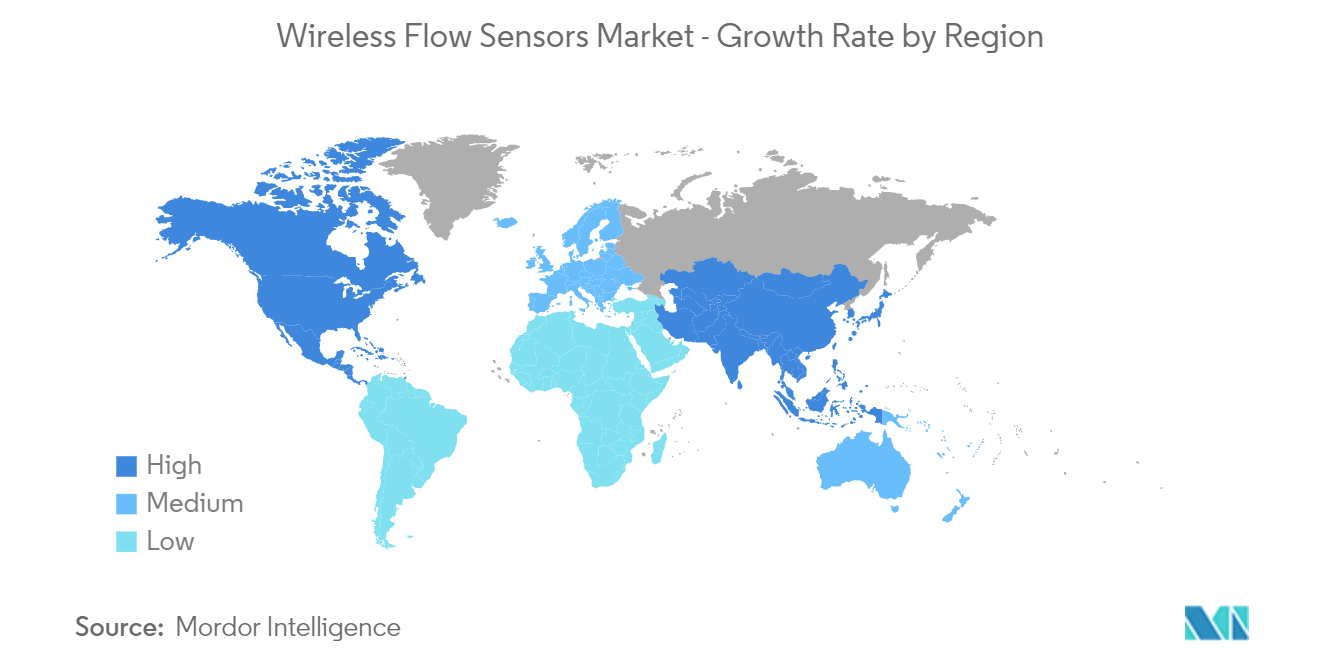
Competitive Landscape
The wireless flow sensors market is very competitive. Some of the significant players in the market are Panasonic Corporation, Honeywell International Inc., Texas Instruments Incorporated, ABB Ltd, Siemens AG, AW-Lake, Emerson Electric Co., Sensata Technologies Inc., and many more. Companies are increasing their market share by forming multiple partnerships and investing in introducing new products to earn a competitive edge during the forecast period.
In March 2022, toward the latest requirements and developments of the Industry 4.0 revolution, ES Systems developed innovative, smart, autonomous, low-power, and wireless sensors ideal for integrating IoT systems and solutions. ES Systems announced the extent of its worldwide distribution channel through three new distribution agreements with the following companies: Nexcomm, Powell, and Servoflo. Through the partnership, ES system will leverage its position in the market and promote its product range of flow sensors worldwide. Moreover, the new partnerships focus on expanding the company's sensors product presence and providing customers with outstanding quality and exceptional customer service.
In July 2021, Endress+Hauser acquired SensAction AG and is now Endress+Hauser Flow Germany AG. The wholly owned subsidiary of Endress+Hauser Flowtec AG, based in Reinach, Switzerland, is now fully integrated into the group. The company aims to be the market leader in ultrasonic flow measurement or flow sensor technology in combination with quality measurements. By combining quality and flow measurement, the company can provide customers with information for process optimization. The company also focuses on using Industry 4.0 solutions to help customers improve efficiency and quality.
Wireless Flow Sensors Industry Leaders
-
Emerson Electric Co.
-
Endress+Hauser Group Services AG
-
AW-Lake
-
Siemens AG
-
Microchip Technology Inc.
- *Disclaimer: Major Players sorted in no particular order
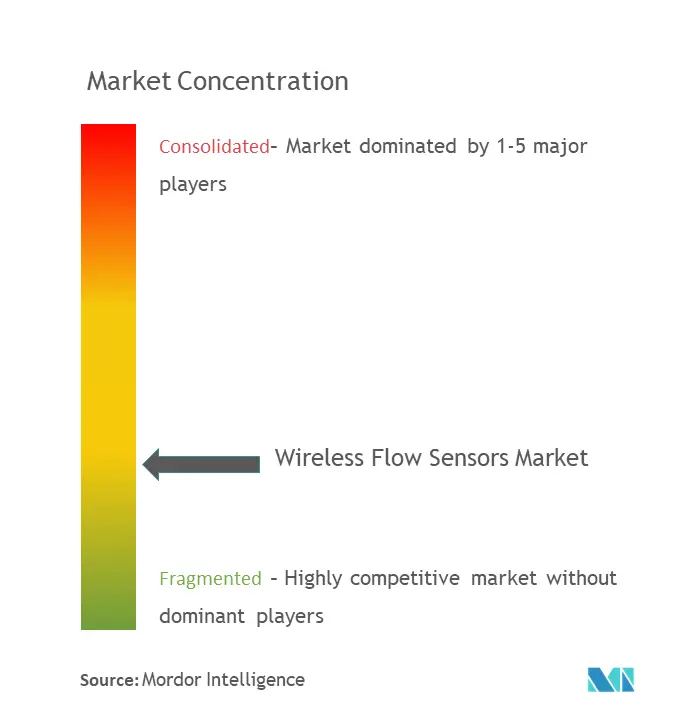
Recent Industry Developments
- September 2022: Wireless technology enabled intelligent field device configuration and diagnostics options for process automation-related mobile applications. Emerson Electric Co's Micro Motion Model 5700 Advanced, Field-Mount, or Truck-Mount Coriolis Transmitter with Wi-Fi connectivity ensures total flow measurement confidence, valuable process insight, and greater operational efficiency. It now has an option for configuration via a Wi-Fi connection. The Wi-Fi option turns the 5700 transmitters into an access point, enabling easy connections with an SSID and WPA2 password.
- July 2021: Endress+Hauser Group Services AG launched its new Proline 10. Promag and Promassflow sensors can be combined with four different Proline 10 transmitters as a compact version. With two status LEDs, these flow sensors can be operated with the SmartBlue app via Bluetooth. These flowmeters cover several basic applications in various industries. The Proline Promag electromagnetic flowmeters are suited for conductive liquids and volume measurement of water and corrosive liquids.
Global Wireless Flow Sensors Market Report Scope
Wireless flow sensor comprises the flow sensor, RF transmitter, and RF receiver. These days, installation doesn't require expensive drilling, trenching, or digging, to install power or input/output wiring. Active and passive safety sensors witnessed significant growth due to the automotive sector's need for accident mitigation systems. The emission of hazardous gases led to rules and regulations for emission control and resulted in monitoring the concentration of exhaust gases.
The wireless flow sensors market is segmented by Technology (Bluetooth, ZigBee, RFID, Wi-Fi, WLAN, EnOcean), Application (Water and Wastewater, Chemicals and Petrochemicals, Power Generation, Other Applications), and Geography (North America, Europe, Asia-Pacific, Latin America, Middle East and Africa). The market sizes and forecasts are provided in terms of value in USD billion for all the above segments.
| Bluetooth |
| ZigBee |
| RFID |
| Wi-Fi |
| WLAN |
| EnOcean |
| Water and Wastewater |
| Chemicals and Petrochemicals |
| Power Generation |
| Other Applications |
| North America |
| Europe |
| Asia-Pacific |
| Latin America |
| Middle East and Africa |
| By Technology | Bluetooth |
| ZigBee | |
| RFID | |
| Wi-Fi | |
| WLAN | |
| EnOcean | |
| By Application | Water and Wastewater |
| Chemicals and Petrochemicals | |
| Power Generation | |
| Other Applications | |
| By Geography | North America |
| Europe | |
| Asia-Pacific | |
| Latin America | |
| Middle East and Africa |
Key Questions Answered in the Report
What is the current Wireless Flow Sensors Market size?
The Wireless Flow Sensors Market is projected to register a CAGR of 27.07% during the forecast period (2025-2030)
Who are the key players in Wireless Flow Sensors Market?
Emerson Electric Co., Endress+Hauser Group Services AG, AW-Lake, Siemens AG and Microchip Technology Inc. are the major companies operating in the Wireless Flow Sensors Market.
Which is the fastest growing region in Wireless Flow Sensors Market?
Asia Pacific is estimated to grow at the highest CAGR over the forecast period (2025-2030).
Which region has the biggest share in Wireless Flow Sensors Market?
In 2025, the North America accounts for the largest market share in Wireless Flow Sensors Market.
What years does this Wireless Flow Sensors Market cover?
The report covers the Wireless Flow Sensors Market historical market size for years: 2019, 2020, 2021, 2022, 2023 and 2024. The report also forecasts the Wireless Flow Sensors Market size for years: 2025, 2026, 2027, 2028, 2029 and 2030.
Page last updated on:
Wireless Flow Sensors Market Report
Statistics for the 2025 Wireless Flow Sensors market share, size and revenue growth rate, created by Mordor Intelligence™ Industry Reports. Wireless Flow Sensors analysis includes a market forecast outlook for 2025 to 2030 and historical overview. Get a sample of this industry analysis as a free report PDF download.
